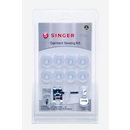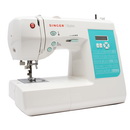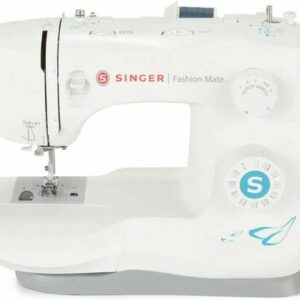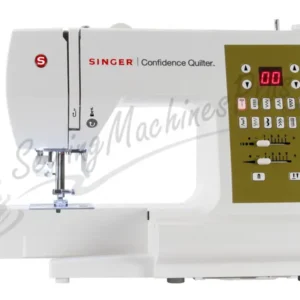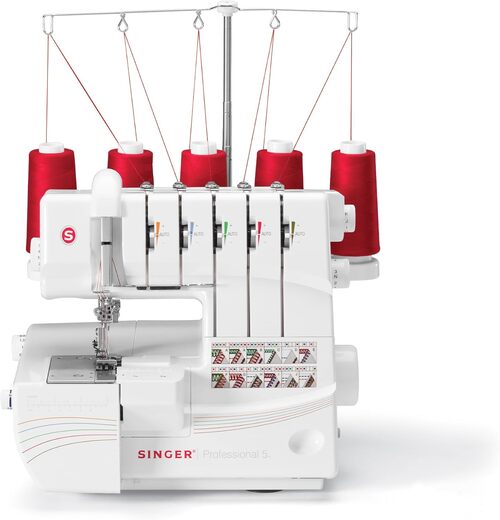
I still remember the day the big brown box landed on my doorstep. I’d been doom-scrolling every Singer 14T968DC review I could find and whispering “don’t overthink it” to myself like a mantra. My faithful old basic machine had retired with a squeak, and I wanted one tool that could both overlock and coverstitch without taking over my tiny sewing nook. Enter the Singer 14T968DC serger — portable enough to shuffle from the dining table to the shelf, but sturdy enough to feel serious.
Unboxing jitters → happy squeals
Under the packing foam sat a surprisingly solid frame, a clear presser foot already on, a trim-bin that snaps under the knife (bless), and a little treasure bag of extra feet. I found the quick guide, then a CD workbook hiding in the box, which I immediately printed and spiral-bound like a study guide. I even labeled the side dials with my label maker — nerdy, yes, but future-me thanks past-me every time.
The first time I threaded it, I tried the tie-on shortcut… then realized it wasn’t the configuration I wanted. Deep breath. I flipped open the front door, followed the color dots, and discovered the tiny lever that flicks thread into the cover looper. Tweezers, headlamp, a mug of tea — ten minutes later I had a clean chain. Day one victory.
First stitches, first grin
My test run was a 4-thread overlock on a slinky rayon jersey tee. The differential feed kept the hem from lettuce-frilling, and the auto-tension landed me surprisingly balanced stitches right away. The motor starts with a little “hum-then-go,” so I trained myself to tap onto a scrap, then glide into the garment. Once I relaxed, the seams looked store-bought and the edges were tidy with zero waviness.
Next up: the coverstitch. Swapping to it felt like a puzzle the first time — move the blade, switch the plate, shift needles, flip the clutch. Now it’s a 7-minute ritual, like making coffee: predictable, quick, worth it. My first real hem — black leggings — came out flat and stretchy. I learned the trick for releasing coverstitch: needle up, a couple gentle handwheel clicks, lift, pull the threads forward, then slide the fabric back. No bird’s nests, no drama.
Where it shines
Over a few weekends, the Singer serger 14T968DC ate through projects:
- Rolled-hem chiffon scarves for gifts — crispy edges and no snagging.
- A cozy fleece hoodie with wide flatlock seams that lay smooth and sporty.
- Denim repairs with the mock safety stitch; I nudged the presser-foot pressure and it strolled over bulky seams.
- Knit tees finished in a single afternoon — overlock the seams, batch the coverstitched hems, done.
I especially love that I can chainstitch to baste waistbands, try on, adjust, and then overlock for keeps — all on the same machine. The Singer 14T968DC sewing machine (yes, technically a serger/coverstitch combo, but it earns the “machine” title) makes that kind of workflow feel easy.
The “keep it real” bits
No rose-colored glasses here — this combo machine has quirks:
- Learning curve: The manual is fine as a quick reference, but the workbook (mine lives in a binder) is the real teacher. I went stitch by stitch for an afternoon with scraps, wrote settings next to each sample, and now I hardly peek at the pages.
- Lighting: The stock bulb is a warm yellow. I swapped in an LED and — hello, daylight.
- Lever location: The presser-foot lever sits to the back-left. Took me a few sessions to stop reaching the wrong way.
- Thread stand & screws: Mine was okay, but I did tighten one set screw after a week of enthusiastic sewing. Keep the little hex wrench handy; it’s a two-minute fix.
- No free arm: Cuffs require a little finesse. I turn them inside out and sew “on the small,” which works fine after a couple tries.
- Auto-tension honesty: Ninety percent of the time it’s spot on. On fussy knits I’ll nudge one dial a whisper and it rights itself.
None of these were deal-breakers. They’re the kind of “learn your machine” notes you’d trade with a sewing friend over coffee.
The portable powerhouse rhythm
Space is tight at my place, so I keep the Singer 14T968DC on a rolling cart. I batch work: serge all seams across a few garments, then flip to coverstitch and hem everything in one session. Switching back and forth in the middle of every seam would make me grumpy; batching turns it into flow. If you hem constantly, you might someday add a dedicated coverstitch, but you absolutely don’t have to. This one does both beautifully.
A few favorite projects (aka confidence boosters)
- Knit dress with curved hem: Differential feed at 1.5 kept the curve smooth; coverstitched hem didn’t tunnel or ripple.
- Outdoor cushion covers: Heavy canvas, long seams — 4-thread overlock chewed through without whining.
- Stretch joggers: Mock safety stitch for seams + narrow coverstitch for hems = athletic-wear vibes without the price tag.
- Holiday napkins: Rolled hems in festive thread made me look weirdly professional at family dinner.
Maintenance and mojo
I give it a quick brush-out every couple of projects, a tiny drop of oil where the manual suggests, and good quality ELx705 needles. The machine thanks me by starting cleanly and keeping stitches consistent. If anything gets finicky, 9 times out of 10 it’s a threading detail. Re-thread calmly, test on a scrap, and you’re back in business.
So… would I buy it again?
This is my honest Singer 14T968DC review in one line: it’s the best value “do-most-things” serger/coverstitch combo I could fit into my space and budget. The Singer 14T968DC serger delivers professional edges, stretchy hems, and dependable speed once you give it a weekend of patience and practice. It’s not an air-thread unicorn, and it won’t hold your hand like a beginner-only model — but that’s exactly why it grows with you.
Why it’s a keeper
- Coverstitch + overlock + chainstitch in one footprint
- Auto-tension that’s genuinely helpful
- Solid, stable build; included trim bin and accessory feet
- Color-coded threading paths that make sense after a couple passes
Why you might pass
- You need a free arm daily
- You want instant, no-learning-curve threading
- You switch between coverstitch and overlock every five minutes (batching is your friend)
Months in, I still get a small jolt of pride when I flip a knit hem and see that clean twin-row from the Singer 14T968DC. It’s the sewing buddy that helped me level up. If you’ve been on the fence, consider this your nudge. Learn it once, and it’ll make you look good for years.
What real buyers say in their Singer 14T968DC reviews?
| Pros – What owners like about the Singer serger 14T968DC | Cons – What frustrates owners of the Singer 14T968DC |
|---|---|
| Excellent value for features (often ~$330–$450 on sale) compared with machines costing 2–8× more. | Steep learning curve. Threading and setup intimidate beginners; many need hours of practice. |
| Two machines in one: overlock + coverstitch/chain stitch (up to 5 threads, 3 needles) on the same unit. | Mode changes are time-consuming. Swapping plates/needles and re-threading to go serger ↔ coverstitch can slow projects; some buyers keep two machines to avoid switching. |
| Strong, even stitches (overlock, flatlock, rolled hem, mock safety stitch, coverstitch) on knits, fleece, denim, and wovens when set up correctly. | Documentation is weak. Printed manual/CD/workbook are confusing, partly outdated/low-res; buyers rely on YouTube and trial-and-error. |
| Auto-tension dial helps many users get balanced stitches with minimal tweaking. | Auto-tension isn’t perfect. Several report it takes an inch or two to “settle,” struggles at bulky seams/curves, and the tension dials aren’t numbered. |
| Threading is doable with practice: color-coded paths, helpful workbook; faster after a few runs. | Finicky/sensitive setup. Miss one guide or order step and it won’t form a stitch; removing coverstitch fabric has a “trick” not clearly explained. |
| Sturdy, heavy, and relatively smooth/quiet for the price; doesn’t “walk” at speed. | Power delivery feels jumpy for some (pedal hums, then sudden start); light is dim/yellow — many swap in an LED. |
| Good accessory pack (multiple presser feet, trim bin) and compatibility notes (users mention feet overlap with Pfaff/Huskylock/Babylock Diana). | Ergonomics quirks: no free arm; presser-foot lever on left rear feels awkward; some wish the foot lifted higher. |
| Handles everyday apparel well; many hobbyists sew tees, leggings, sweatshirts, home décor with “RTW” results. | Heavy layers can challenge the knives/feeding on thick seams; occasional advice to raise/adjust the lower blade. |
| Owners report long-term satisfaction once mastered; some buy a second 14T968DC to leave one set for coverstitch. | Quality-control issues pop up: missing parts (guards, screws, catcher), loose knife pin, faulty tension dial, flimsy thread stand. |
| Works with ELx705 needles and quality thread for best results. | Customer service & parts pain. Mixed warranty experiences, delays or N/A parts (e.g., coverstitch plate), limited local service for some regions. |
| Plenty of community resources. Users share that downloaded workbooks and third-party videos make a big difference. | Not beginner-friendly overall. Several experienced sewists say it’s better for intermediate/advanced users. |
| Compact alternative to two separate machines if space/budget are tight. | No built-in thread cutter; pedal cord can feel short; waste-bin plastic feels cheap to some. |
Singer 14T968DC Serger – Frequently Asked Questions
What is the Singer 14T968DC?
Quick Singer 14T968DC review: it is a 5-thread combo that works as a serger and a coverstitch machine, with an Auto Tension Dial and 14 stitch types for finishing, seaming, and hemming in one compact Singer 14T968DC sewing machine.
Which stitches can it sew?
This Singer 14T968DC serger handles double chainstitch, 2-thread wrapped edge and 2-thread overedge, 3-thread overlock and flatlock, 3- and 4-thread ultra-stretch mock safety stitches, 4- and 5-thread safety stitches, narrow and wide cover stitches, a triple cover stitch, plus rolled hems.
Is threading difficult?
Threading is color-coded: green upper looper, red lower looper, brown chain/cover looper, blue right needle, orange left or chain needle. Follow the diagram inside the looper cover and thread in order, or use the tie-on method to swap colors faster; raise the presser foot to release the tension discs.
What needles does the Singer serger 14T968DC use?
Use Singer needle #2022 in sizes 11/80 or 14/90 only; standard household needles are not supported. The clamp has five positions, but you sew with up to three needles at a time.
How do I switch from overlock to coverstitch?
Power off, disengage the upper knife, move the seam-width finger to R, switch the L/C clutch to Cover/Chain, disengage the upper looper, install the seam-guide plate, then thread the cover looper and cover needles as shown in the manual.
How do I start and finish a coverstitch cleanly?
Start with the fabric placed behind the needles, then sew. You cannot chain off at the end of a coverstitch; pull the needle threads to the back and tie them with the looper thread to secure. Set coverstitch length a bit above N (about 2.5 mm).
What are the stitch-length and seam-width ranges?
Typical stitch length is N to 4 depending on fabric. Overedge width is 4 mm with the right needle and 6 mm with the left needle, and you can fine-tune with the width knob (about 3.0–5.0 mm right, 5.0–7.0 mm left).
How does the Auto Tension Dial work?
Choose the letter for your stitch on the Auto Tension Dial, then, if needed, fine-tune each thread using the small levers to match your fabric and thread; the manual shows clear tension balance examples per stitch.
How do I stop wavy seams on knits?
Use Differential Feed: set above N to prevent stretching or tunneling, or below N to gather; the differential ratio ranges from 1:0.6 to 1:2.0.
How do I disengage or re-engage the cutting knife?
Open the looper cover, slide the movable knife holder to the right and rotate to lock it in the non-working position; rotate back to bring it into work again. Always close the cover before sewing.
Any safety basics I should know?
Always unplug before threading, changing needles, feet, plates, or the bulb; use the supplied foot controller; keep air openings clean; and note the Singer 14T968DC will not run with the looper cover open.
What comes in the box?
An accessory case with screwdrivers, extra stationary knife, spool caps, anti-spill nets, oiler, small Allen key, tweezers, needle set, brush, cone adapters, a waste tray, and a soft cover.
How do I change thread colors quickly?
Clip the old thread at the spool, tie the new color with a small knot, raise the presser foot, gently pull threads through the path, and rethread the needle eyes if the knots reach them. This saves time on the Singer 14T968DC serger.
How do I adjust for thick or delicate fabrics?
Use the presser-foot pressure dial (1 light to 5 heavy, N normal) and the cutting-width knob to match fabric weight. For rolled hems, set the seam-width finger to R. Test on scraps first for the best Singer serger 14T968DC results.
Where do I find quick setup tips?
Keep the color-coded threading diagram inside the looper cover handy, label your dials, and practice chaining off and test-sewing any time you rethread. These small steps make the Singer 14T968DC sewing machine easier to use day-to-day.
| Specification | Details |
|---|---|
| Model | SINGER Professional 14T968DC |
| Machine type | 2–5 thread overlock/coverstitch combination machine (supports double chain stitch, overedge/overlock, flatlock, rolled hem, and coverstitch). |
| Maximum sewing speed | 1,300 stitches per minute (spm). |
| Stitch length (feed amount) | 1–4 mm (standard: rolled hem 1–2; ordinary overedge N=2.5). |
| Differential feed ratio | 1:0.6 – 1:2.0. |
| Overedge stitch width | Rolled hem: 1.5 mm; ordinary overedge: 3.0–9.8 mm (standard 4 mm). |
| Coverstitch needle gauge (spacing) | Two needles: 2.8 mm (narrow) or 5.6 mm (wide); Triple needles: 5.6 mm. |
| Needle bar stroke | 27 mm. |
| Presser foot lift (rise) | 4.5 mm. |
| Needle system & sizes | Singer #2022 (ELx705), sizes #14/90 and #11/80. |
| Number of threads | 2 to 5. |
| Dimensions (W × D × H) | 360 × 290 × 300 mm (≈ 14.2″ × 11.4″ × 11.8″). |
| Weight | 9.0 kg (≈ 19.8 lb). |
| Light bulb | Replace with same type rated 15 W (unplug before replacing). |
| Foot controller | Use only the provided controller (Type 4C-316B for U.S.A. & Canada). |

